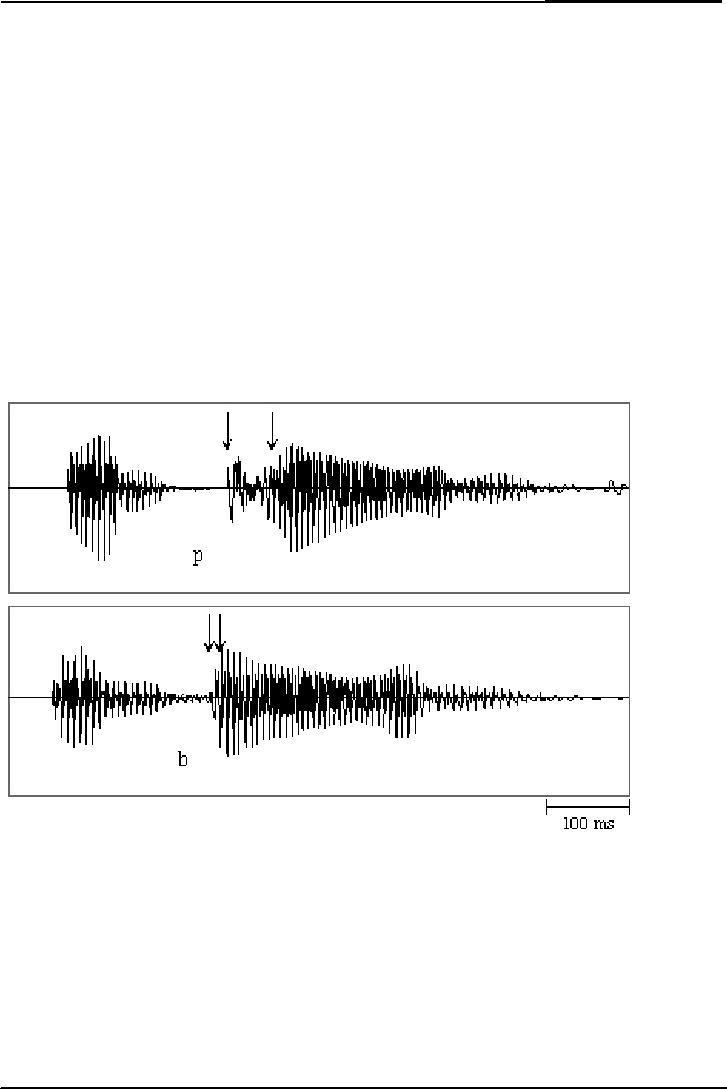 |
PATTERN RECOGNITION (continued):Adaptation paradigm |
| << PATTERN RECOGNITION:Implications, Phonemes, Voicing, Place of articulation |
| PATTERN RECOGNITION (continued):Gestalt Theory of Perception >> |

Cognitive
Psychology PSY 504
VU
Lesson
16
PATTERN
RECOGNITION (continued)
Voice-Onset
Time
Voice
is human sound and onset
means beginning. In the
pronunciation of such consonants
as
[b]
and [p], two things
happen: Closed lips are
opened, releasing air and
the vocal cords
begin
vibrating
(voicing). In voiced consonants
such as [b], the release of
air and voicing is
nearly
simultaneous.
In unvoiced consonants such as
[p], the release occurs 60
ms before the
vibration
begins.
What we are detecting when
we perceive a voiced consonant
versus an unvoiced
consonant
is the presence or absence of a 60 ms
interval between release and
voicing. This
period
of time is called Voice-Onset
Time.
And
when release and voicing
come at the same time
then it is called voiced
sound like ba.
An
experiment was conducted to
identify the voice-onset
time. They presented two
words anbil
and
anpil. They wanted to know
the voice timing difference
between b and p. The diagram
is
showing
results. In Sound wave the
first arrow is showing
release. Second arrow is
showing
voicing.
And the difference is 60 ms. P
has long interval between
release and voicing and b
has
short
interval.
Adaptation
paradigm
Eimas
& Corbit (1973) conducted an
experiment that called
adaptation paradigm. When we
listen
a
sound again and again we
expect this sound will
not come again. This is
called the fatigue
paradigm
or adaptation paradigm.
Eimas
and Corbit had their
subjects listen to repeated
presentations of da (voiced). This
sound
involves
a voiced consonant, [d].
They then presented objects
with a series of artificial
sounds
that
spanned the acoustic
continuum such as that
between ba (voiced) and pa
(voiceless).
Subjects
had to indicate whether each
of these artificial stimuli
sounded more like ba or more
pa.
They
found that subjects who
under normal conditions
would report ba as ba were
now reporting
it
as pa. They found that
subjects who under normal
conditions would report ba as ba
were now
reporting
it as pa. They reasoned that
repeated voicing makes the
perceptual system adapt
to
45

Cognitive
Psychology PSY 504
VU
voicing
and expect unvoiced stimuli.
This experiment is very
important because it tells us
not the
sound
but itself features are
being detected. That is a
critical thing about the
series of experiment.
Basic
features of feature analysis
model;
Cognitive
psychology is trying to find
the causes of these types of
mistakes. Because
usually
behind
these mistakes, is a theory or
model.
Whenever
we can not see the
problems we can not find
the weakness of systems. So we
can not
explain
any system without
understanding its
process.
In
model of hearing we talk
about template matching.
There are thousands of
sounds in the
world.
Like different sounds make
by tonga wala have meanings
in other languages. Sounds
are
different
in different languages. A small
feature can change all
meanings of sentence or
words.
Some
words vary with
tone.
Cognitive
psychology is not just about
laboratory experiments. It is about
our daily life.
Speech
recognition
is also related with its
features.
46
Table of Contents:
- INTRODUCTION:Historical Background
- THE INFORMATION PROCESSING APPROACH
- COGNITIVE NEUROPSYCHOLOGY:Brains of Dead People, The Neuron
- COGNITIVE NEUROPSYCHOLOGY (CONTINUED):The Eye, The visual pathway
- COGNITIVE PSYCHOLOGY (CONTINUED):Hubel & Wiesel, Sensory Memory
- VISUAL SENSORY MEMORY EXPERIMENTS (CONTINUED):Psychological Time
- ATTENTION:Single-mindedness, In Shadowing Paradigm, Attention and meaning
- ATTENTION (continued):Implications, Treisman’s Model, Norman’s Model
- ATTENTION (continued):Capacity Models, Arousal, Multimode Theory
- ATTENTION:Subsidiary Task, Capacity Theory, Reaction Time & Accuracy, Implications
- RECAP OF LAST LESSONS:AUTOMATICITY, Automatic Processing
- AUTOMATICITY (continued):Experiment, Implications, Task interference
- AUTOMATICITY (continued):Predicting flight performance, Thought suppression
- PATTERN RECOGNITION:Template Matching Models, Human flexibility
- PATTERN RECOGNITION:Implications, Phonemes, Voicing, Place of articulation
- PATTERN RECOGNITION (continued):Adaptation paradigm
- PATTERN RECOGNITION (continued):Gestalt Theory of Perception
- PATTERN RECOGNITION (continued):Queen Elizabeth’s vase, Palmer (1977)
- OBJECT PERCEPTION (continued):Segmentation, Recognition of object
- ATTENTION & PATTERN RECOGNITION:Word Superiority Effect
- PATTERN RECOGNITION (CONTINUED):Neural Networks, Patterns of connections
- PATTERN RECOGNITION (CONTINUED):Effects of Sentence Context
- MEMORY:Short Term Working Memory, Atkinson & Shiffrin Model
- MEMORY:Rate of forgetting, Size of memory set
- Memory:Activation in a network, Magic number 7, Chunking
- Memory:Chunking, Individual differences in chunking
- MEMORY:THE NATURE OF FORGETTING, Release from PI, Central Executive
- Memory:Atkinson & Shiffrin Model, Long Term Memory, Different kinds of LTM
- Memory:Spread of Activation, Associative Priming, Implications, More Priming
- Memory:Interference, The Critical Assumption, Limited capacity
- Memory:Interference, Historical Memories, Recall versus Recognition
- Memory:Are forgotten memories lost forever?
- Memory:Recognition of lost memories, Representation of knowledge
- Memory:Benefits of Categorization, Levels of Categories
- Memory:Prototype, Rosch and Colleagues, Experiments of Stephen Read
- Memory:Schema Theory, A European Solution, Generalization hierarchies
- Memory:Superset Schemas, Part hierarchy, Slots Have More Schemas
- MEMORY:Representation of knowledge (continued), Memory for stories
- Memory:Representation of knowledge, PQ4R Method, Elaboration
- Memory:Study Methods, Analyze Story Structure, Use Multiple Modalities
- Memory:Mental Imagery, More evidence, Kosslyn yet again, Image Comparison
- Mental Imagery:Eidetic Imagery, Eidetic Psychotherapy, Hot and cold imagery
- Language and thought:Productivity & Regularity, Linguistic Intuition
- Cognitive development:Assimilation, Accommodation, Stage Theory
- Cognitive Development:Gender Identity, Learning Mathematics, Sensory Memory